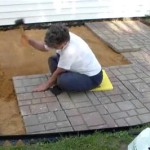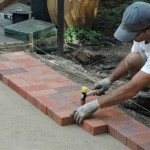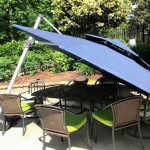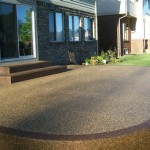How To Clean Concrete Patio With a Pressure Washer
Concrete patios, while durable and aesthetically pleasing, are susceptible to the accumulation of dirt, grime, mildew, algae, and other unsightly stains. Regular cleaning is essential to maintain the patio's appearance and prevent long-term damage. A pressure washer is a highly effective tool for cleaning concrete patios, offering a powerful and efficient way to remove stubborn dirt and stains. This article provides a comprehensive guide on how to clean a concrete patio using a pressure washer, outlining the necessary preparations, safety precautions, and step-by-step procedures.
Before commencing the cleaning process, it is crucial to assess the patio's condition and determine the appropriate cleaning approach. Factors to consider include the type and severity of the stains, the age of the concrete, and the presence of any sealants or coatings. Older concrete may be more porous and require a gentler cleaning approach to avoid damage. Similarly, sealed or coated concrete may be susceptible to damage from high-pressure settings and abrasive cleaning agents. A careful evaluation will help determine the optimal pressure setting, nozzle selection, and cleaning solutions.
The most important considerations involve preparation before beginning the cleaning, safety measures during the process, and specific techniques for effectively removing various types of stains and debris. Each of these elements contributes to a successful and damage-free cleaning experience.
Preparation is Key: Gathering Supplies and Preparing the Area
Prior to using a pressure washer, several preparatory steps are necessary to ensure a safe and effective cleaning process. These steps involve gathering the required materials, preparing the patio area, and taking appropriate safety precautions.
Gather the necessary supplies. A pressure washer is the primary tool, but several ancillary items are required. This includes appropriate nozzles, such as a wide-angle nozzle (40-degree or 25-degree) for general cleaning and a zero-degree nozzle or turbo nozzle for particularly stubborn stains. Cleaning solutions formulated for concrete are also essential. Look for products designed to remove mold, mildew, algae, and oil stains. A stiff-bristled brush, a garden hose, safety glasses, gloves, and appropriate footwear are also needed.
Prepare the patio area by removing all furniture, planters, and other items from the patio surface. This provides unrestricted access to the entire area and prevents damage to personal belongings. Sweep or blow away loose debris, such as leaves, twigs, and dirt. This initial cleaning step removes surface-level contaminants, allowing the pressure washer to focus on embedded stains and grime. Inspect the patio for any cracks or damage. Note these areas, as they may require more careful attention during the cleaning process to avoid further damage.
Protect surrounding areas. Cover any nearby plants, shrubs, or delicate surfaces with plastic sheeting to prevent damage from the pressure washer spray or cleaning solutions. It is also prudent to inform neighbors of the intended cleaning activity, especially if it is likely to generate noise or spray. Consider the drainage of wastewater. Ensure that the runoff will not damage landscaping or flow into storm drains. If necessary, use sandbags or other barriers to redirect the water flow.
Safety First: Protecting Yourself and Your Property
Operating a pressure washer involves inherent risks, and prioritizing safety is paramount. Understanding and implementing appropriate safety measures can significantly reduce the likelihood of accidents and injuries.
Wear appropriate personal protective equipment (PPE). Safety glasses are essential to protect the eyes from flying debris and splashes. Gloves protect the hands from harsh chemicals and the force of the water. Closed-toe shoes or boots with non-slip soles are necessary to prevent slips and falls. Ear protection is advisable if the pressure washer produces a high noise level.
Understand the pressure washer's operation. Familiarize oneself with the pressure washer's controls, including the pressure adjustment settings, nozzle selection, and safety mechanisms. Read the manufacturer's instructions thoroughly before operating the machine. Start with the lowest pressure setting and gradually increase it as needed. Excessively high pressure can damage the concrete surface or cause personal injury.
Maintain a safe distance. Keep a safe distance from the surface being cleaned. The force of the water can propel debris at high speeds, posing a risk of injury. Avoid pointing the pressure washer wand at oneself or others. Never allow children or pets to play near the pressure washer during operation.
Be mindful of electrical safety. If using an electric pressure washer, ensure that it is plugged into a ground fault circuit interrupter (GFCI) outlet to prevent electrical shock. Avoid using extension cords unless absolutely necessary, and if used, ensure that they are rated for outdoor use and capable of handling the pressure washer's amperage requirements. Keep the power cord away from water and avoid operating the pressure washer in wet conditions.
The Cleaning Process: Techniques for Effective Stain Removal
With the preparations and safety measures in place, the concrete patio is ready for cleaning. The following steps outline the process of effectively removing dirt, grime, and stains using a pressure washer.
Pre-soak the concrete surface. Wet the entire patio surface with a garden hose or the pressure washer using a low-pressure setting. This helps to loosen dirt and grime, making it easier to remove with the pressure washer. Apply a concrete cleaner, if needed. If the patio has stubborn stains, apply a concrete cleaner specifically designed for the type of stain being addressed. Follow the manufacturer's instructions for application and dwell time. For example, for mold and mildew, a solution containing bleach may be effective. For oil stains, a degreaser may be necessary. Use a stiff-bristled brush to scrub the cleaner into the surface, focusing on heavily stained areas.
Pressure wash the patio. Start with a wide-angle nozzle (40-degree or 25-degree) and the lowest pressure setting. Hold the pressure washer wand at a 45-degree angle to the surface and maintain a consistent distance to avoid damaging the concrete. Use overlapping strokes to clean the entire patio surface, working in a systematic manner to ensure even coverage. Move slowly and steadily, allowing the pressure washer to remove the dirt and grime. If necessary, gradually increase the pressure setting until the desired cleaning effect is achieved. Avoid holding the nozzle too close to the concrete surface, as this can cause etching or damage.
Address stubborn stains. For particularly stubborn stains, such as oil stains or rust, use a smaller nozzle (zero-degree or turbo nozzle) or a higher pressure setting. However, exercise caution when using these more aggressive cleaning methods, as they can potentially damage the concrete surface. Focus on the stained areas specifically and avoid prolonged exposure to the high-pressure spray. Consider using a specialized cleaning solution designed for the specific type of stain. Apply the solution, allow it to dwell for the recommended time, and then pressure wash the area again.
Rinse the patio thoroughly. After cleaning the entire patio surface, rinse it thoroughly with clean water to remove any remaining cleaning solution and loosened debris. Use a wide-angle nozzle and a low-pressure setting to avoid damaging the concrete. Ensure that all traces of the cleaning solution are removed, as residue can attract dirt and grime over time. Allow the patio to dry completely before replacing furniture or allowing foot traffic.
Post-cleaning Considerations: Sealing and Maintenance.
Clean concrete is more porous than uncleaned concrete because the cleaning process opens up the pores. Sealing the concrete patio after cleaning can help protect it from future stains, water damage, and deterioration. A concrete sealer creates a barrier that repels water and oil, making it easier to clean and maintain the patio in the long run. Choose a sealer that is specifically designed for concrete patios and follow the manufacturer's instructions for application. Regularly cleaning the patio with a mild detergent and water will help prevent the buildup of dirt and grime and extend the lifespan of the sealer. Consider spot-cleaning stains as soon as they occur to prevent them from setting in.

Best Way To Clean A Concrete Patio Chalking Up Success

How To Pressure Wash Concrete Driveways Patios Network

How To Clean A Concrete Patio Maintenance Tips Network

How To Clean Patio Slabs Minster Paving

How To Clean Concrete The Easy Way Porches Patios Driveways More Run Radiance

How To Clean Concrete Professional Pressure Washing Vs Diy Washh

Diy Miracle Concrete Patio Cleaner I Should Be Mopping The Floor

How To Clean A Concrete Patio Fast

Transforming A Concrete Patio With Pressure Washing Rolling Suds

How To Re Your Concrete Patio With Power Washing Wiseguys Pro Wash
Related Posts








